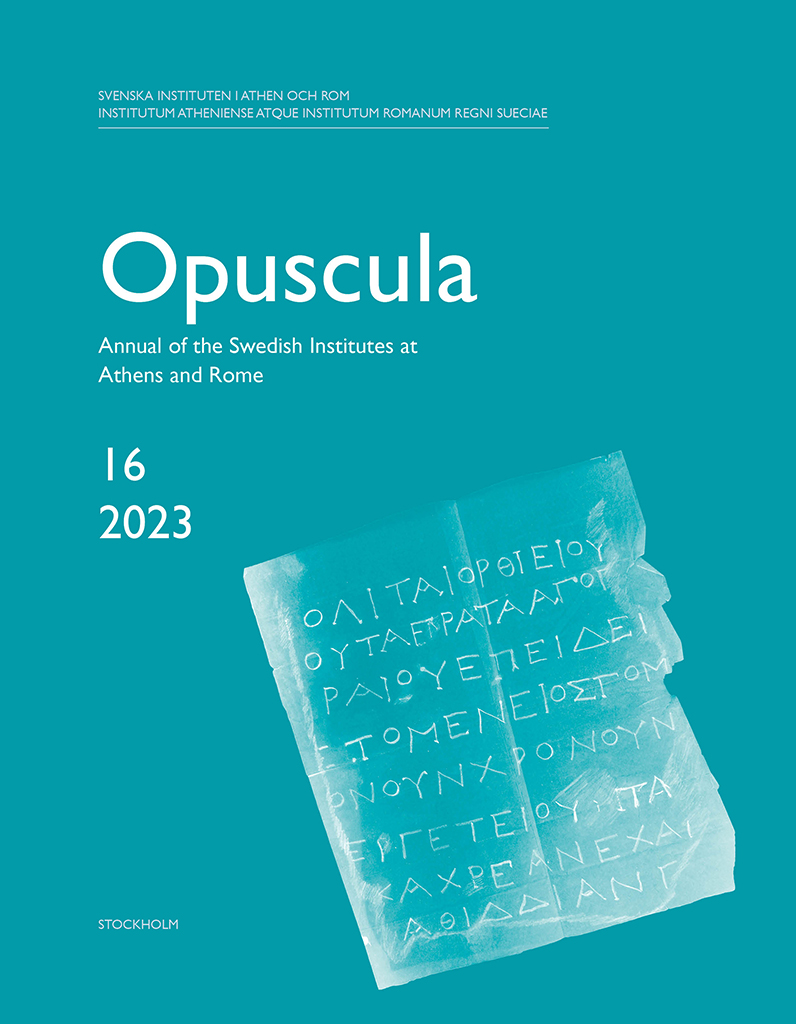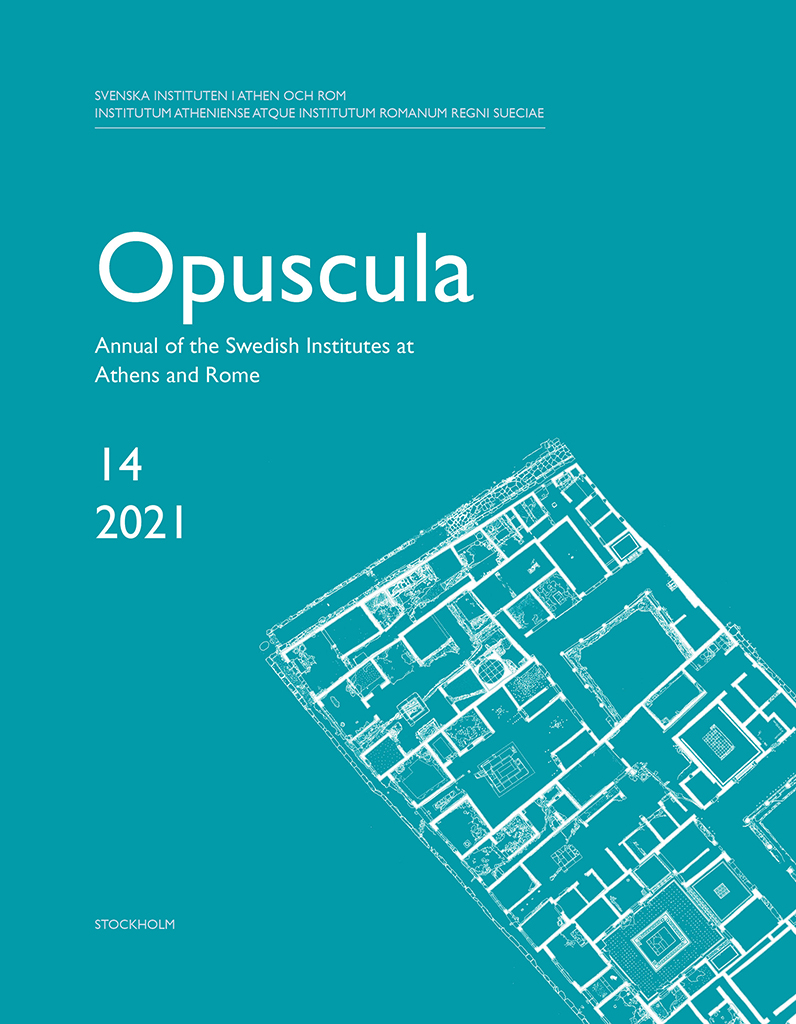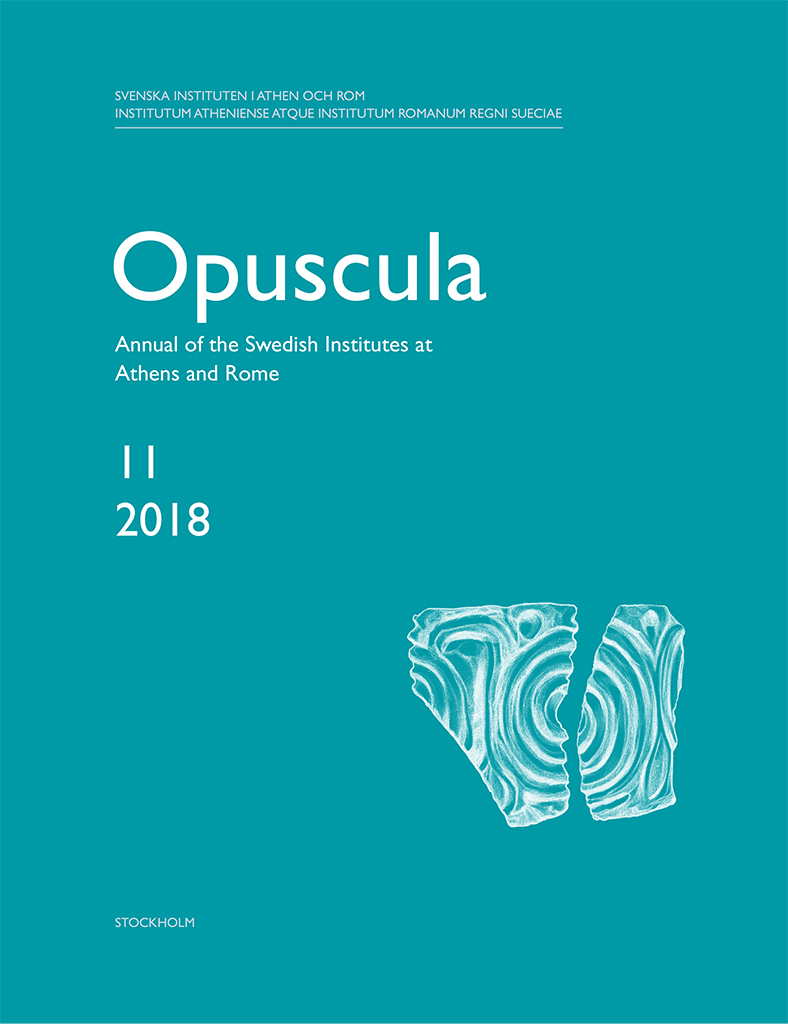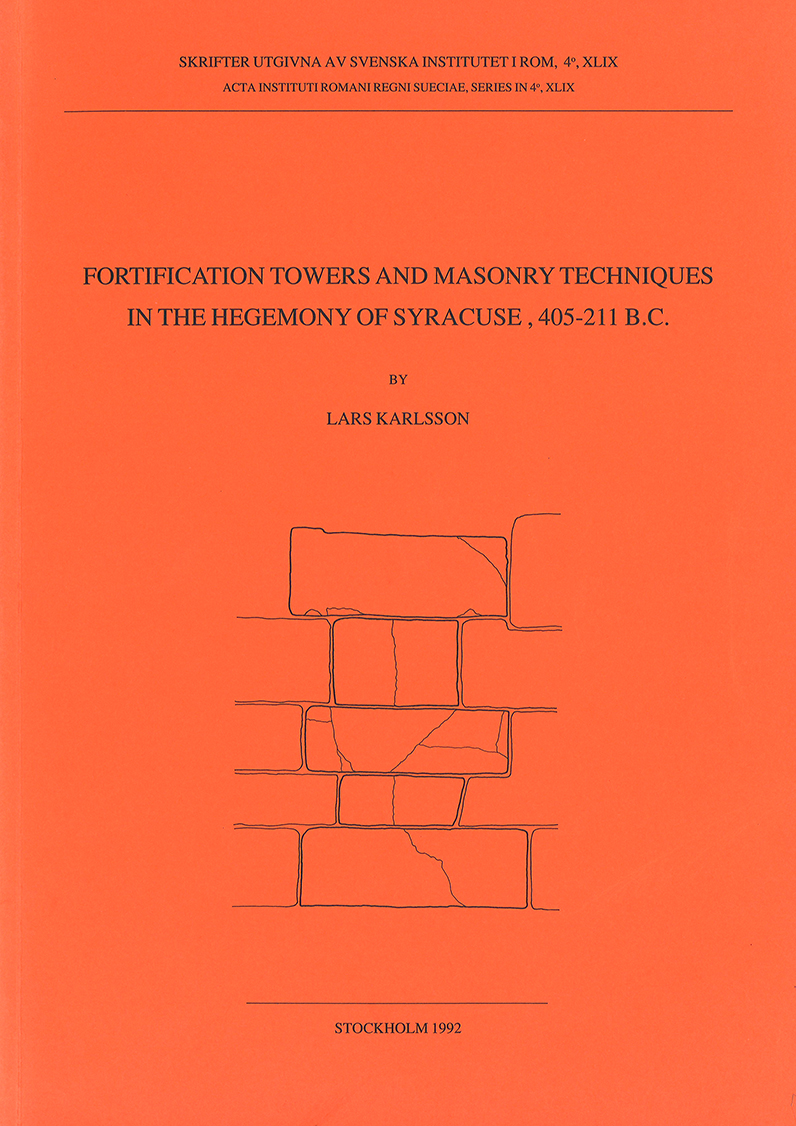Opuscula is published by the Swedish Institutes at Athens and Rome, with the aid of a grant from the Swedish Research Council. Distributed by Eddy.se AB. View journal at ERIH PLUS. All content available with open access. A bronze deposit excavated at Kalaureia in 2016. A statuette of the Herakles Chiaramonti type, a stand and a thymiaterion By Julia Habetzeder (Swedish Institute at Athens & Stockholm University) Abstract This article presents three bronzes found on the island of Poros in 2016, during excavations in Area L, the presumed area of Kalaureia’s ancient settlement, c. 200 m to the south of the Sanctuary of Poseidon. The deposit included: 1. A statuette of the Herakles Chiaramonti type, here suggested to have been produced during the 2nd or 1st century BC; 2. A stand which may have functioned as a thymiaterion (incense burner) or a lamp stand. Judging from close parallels the stand was most likely produced during the 5th or 4th century BC; 3. A high-stemmed dish, which is interpreted as a thymiaterion contemporary with the stand. The items are tentatively suggested to have been used together, perhaps in religious veneration of Herakles. The bronzes are suggested to have been deposited either for what was intended to be temporary…
Opuscula is published by the Swedish Institutes at Athens and Rome, with the aid of a grant from the Swedish Research Council. Distributed by Eddy.se AB. View journal at ERIH PLUS. All content available with open access. A preliminary report on sculptures and figurative terracottas found at the site of Vlochos, region of Karditsa, Thessaly By Stelios Ieremias & Robin Rönnlund Abstract The existence of an ancient city at Thessalian Vlochos was first established by the discovery in 1964 of several inscribed stelai at a quarry at the site, which in turn prompted its declaration as a protected archaeological zone. A large spoil-heap with mixed soils and quarry debris had been left after the closure of the quarry, and this was examined and removed as part of the ongoing Greek-Swedish archaeological collaboration at the site. Apart from quarry debris and rubbish, the soils of the heap yielded considerable amounts of pottery and tile, and also architectural members, terracotta figurines, stelai, marble statuettes, and votives. The mixed nature of the soils made all finds ex situ, but the composition of the material provides a transect of the chronology of the site at Vlochos, as well as strong indications of cult, including evidence…
Opuscula is published by the Swedish Institutes at Athens and Rome, with the aid of a grant from the Swedish Research Council. Distributed by Eddy.se AB. View journal at ERIH PLUS. All content available with open access. The Palamas Archaeological Project. A preliminary report of the 2022 fieldwork conducted by the ongoing Greek–Swedish archaeological field programme in Palamas, region of Karditsa, Thessaly By Maria Vaïopoulou, Robin Rönnlund, Fotini Tsiouka, Johan Klange, Derek Pitman, Rich Potter, Ian Randall, Harry Manley, Elisabet Schager, Sotiria Dandou & Lewis Webb Abstract This paper presents the preliminary results from the 2022 fieldwork of the Palamas Archaeological Project, an ongoing Greek–Swedish collaboration in the region of Karditsa, Thessaly. Working over the course of two separate field seasons, the project team conducted aerial, architectural, fieldwalking, and geophysical surveys at a number of sites within the survey area, including at the important multi-phase fortified settlements at Metamorfosi and Vlochos. Limited excavations were also conducted at the latter site, producing new evidence for the Hellenistic and Early Byzantine phases of the ancient city, including a probable cemetery. The work continues to add to the knowledge of the archaeology of the region, highlighting the long and dynamic history of human habitation in western…
Opuscula is published by the Swedish Institutes at Athens and Rome, with the aid of a grant from the Swedish Research Council. Distributed by Eddy.se AB. View journal at ERIH PLUS. All content available with open access. Late Etruscan tripod thymiateria By Örjan Wikander Abstract This article is a further development of questions raised in my review of Laura Ambrosini’s magisterial Thymiateria etruschi in bronzo (2002), and it is mainly based upon material gathered by her. Whereas I mostly agree with Ambrosini’s conclusions, the discussion includes some dissent concerning production centres (Chiusi and Tarquinia in particular), chronology (beginning and end-date of production), and the function of the censers. Otherwise, a series of case studies clearly confirms the basic correctness of Ambrosini’s division of the thymiateria by different production centres. The article also expands my earlier views on the varying modes of production and the possible importance of Roman leges sumptuariae for the southern limit of thymiateria diffusion. Except for that, the investigation reveals no traces of influence from the Roman wars and the contemporaneous romanization, but perhaps of the importance of the stands for family status and cultural identity. Bibliographical information Örjan Wikander, ‘Late Etruscan tripod thymiateria’, Opuscula. Annual of…
Opuscula is published by the Swedish Institutes at Athens and Rome, with the aid of a grant from the Swedish Research Council. Distributed by Eddy.se AB. View journal at ERIH PLUS. All content available with open access. The Invitation to the Dance. An intertextual reassessment By Julia Habetzeder (Uppsala University, Sweden) Abstract With its original manifestation generally dated to c. 150 BC, the Invitation to the Dance is a textbook example of Hellenistic sculpture. But despite much scholarly attention there is still no consensus as to what motif the sculpture group depicts. Inspired by intertextual theory, this study catalogues and re-examines 35 sculptures of the female figure and 34 sculptures of the satyr. The article focuses on preserved sculptures, rather than a reconstructed model image. Variations of the repeated forms are highlighted as significant for the interpretation of the types. The reading of the Invitation to the Dance thus put forward suggests that the group composition displays the moment after the satyr has pulled the female’s garment down from her upper body. It is furthermore emphasized that both satyr and female figure were at times—perhaps even predominately—displayed as solitary figures. The satyr’s foot-clapper is suggested to have been included primarily in…
Opuscula is published by the Swedish Institutes at Athens and Rome, with the aid of a grant from the Swedish Research Council. Distributed by Eddy.se AB. View journal at ERIH PLUS. All content available with open access. The use of miniature pottery in Archaic–Hellenistic Greek sanctuaries. Considerations on terminology and ritual practice By Signe Barfoed (Independent scholar, Norway). Abstract Miniature pottery is a widely encountered group of archaeological material that has been found in domestic, funerary, and predominantly in ritual contexts. Despite the ubiquitous presence of these small vessels, this group is generally understudied and interpretations of its meaning are lacking. Scholarship in the past perceived miniature pottery as cheap, non-functional and unimportant and therefore this pottery was often neglected or sometimes not even published. Interpretations have been sparse and by default it is believed that miniatures were the cheapest dedications the worshipper could buy. Within the last decade(s) the perceptions among scholars have changed somewhat and when miniature pottery and other votives appear together in an excavation it is often interpreted as a votive deposit stemming from a ritual context, such as a temple, shrine or sanctuary. Below a tentative terminology of miniature pottery will be presented and it…
Opuscula is published by the Swedish Institutes at Athens and Rome, with the aid of a grant from the Swedish Research Council. Distributed by Eddy.se AB. View journal at ERIH PLUS. All content available with open access. New inscriptions in the Bodrum Museum. A Hellenistic foundation from the area of Mylasa By Signe Isager Abstract This article presents two hitherto unknown Hellenistic inscriptions, both of which are fragmentary. They are inscribed on two sides of a stone which is now in the Museum of Underwater Archaeology in Bodrum (inv. no. 6651) but probably originated from the area of Mylasa. Both inscriptions concern a private foundation that is referred to as the syngeneia in inscription A. The foundation seems to be of a type already known from Halikarnassos, Kos and Thera, for example. This article aims to make the two inscriptions available not least to the many scholars studying associations and foundations. Bibliographical information Signe Isager, ‘New inscriptions in the Bodrum Museum. A Hellenistic foundation from the area of Mylasa’, Opuscula. Annual of the Swedish Institutes at Athens and Rome (OpAthRom) 7, Stockholm 2014, 185–192. ISSN: 2000-0898. ISBN: 978-91-977798-6-9. Softcover, 257 pages. https://doi.org/10.30549/opathrom-07-10 See also Conference: Berit Wells in memoriam
Published by the Swedish Institute of Classical Studies in Rome. Distributed by Astrom Editions. Fortification towers and masonry techniques in the hegemony of Syracuse, 405–211 B.C. By Lars Karlsson Abstract Syracuse assumed the leadership of the Greek cities after the Carthaginian wars of 409–405 B.C. and the first chapter discusses the four main periods which can be discerned in the archaeological material: (1) the rule of Dionysios I, 405–367 B.C., (2) the period of Timoleon, 244–c. 316 B.C., (3) Agathokles, 316–289 B.C., and (4) the rule of King Hieron II, 270/69–215 B.C. Pyrrhos, as king of Syracuse in 278–276 B.C., was also responsible for work on Sicilian fortifications. Towers with internal crosswalls are treated in Chapter Two and they appear in two types. The first group consists of seven towers with internal walls in the shape of a T (the ‘Epipolai Towers’). The towers are large and square, measuring 10–12 m. (around 30–35 Doric ft.) on a side. The second group of towers with interior walls in the shape of a Greek cross, is common in Sicily. Twelve square examples are known (plus two circular and two semicircular). The square towers frequently measure 6.60 m. (20 Doric ft.) on a…







